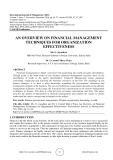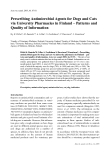
Ms. G. Jayashree and Dr. I. Carmel Mercy Priya
http://www.iaeme.com/IJ
Capital budgeting is the process of making investment decisions in capital expenditure. These are
expenditures
, the benefits of which are expected to be received over a long period of time exceeding one
year. The finance manager has to assess the profitability of various projects before committing the funds.
Some of the major
Accounting Rate of Return method 3. Net present value method 4. Internal Rate of Return Method 5.
Profitability index.
7.1. Payback Period
The payback (or payout) period is the most popularly and commonly used
the number of years required to recover the invested amount (original cash outlay) invested in the project.
It is one of the easiest traditional method that derives the years taken for the firm to take back its invested
amount
for a project. If the project generates constant annual cash inflows, the payback period can be
computed by dividing cash outlay by the annual cash inflow.
Payback period = Cash outlay (investment) / Annual cash inflow = C / A
7.2. Accounting Rate of Retu
The Accounting rate of return (ARR) method used to find the average income derived from average
investment. It simply means the earnings obtained out of the investment made. It uses accounting
information, as revealed by financial statements, to
The accounting rate of return is calculated by dividing the average income after taxes by the average
investment.
ARR= Average income/Average Investment
7.3. Net Present Value M
The net present
value (NPV) method is a popular method in the capital budgeting techniques. It is the
process of calculating the present value of cash flows (inflows and outflows) of an investment proposal,
using the cost of capital as the appropriate discounting rate. I
whether the project (investment) needs to be accepted or rejected with a simple substitute of future cash
flows.
Net Present Value (NPV) is the difference between the present value of cash inflows and the present
val
ue of cash outflows. NPV is used
projected
investment or project.
The following is the formula for calculating NPV:
Where ;
C
t
= net cash inflow during the period t
C
o
= total initial investment costs
r =
discount rate, and
t = number of time periods
A positive net present value indicates that the projected
exceeds the anticipated costs. Generally, an investment with a positive NPV will
one with a negative NPV will result in a
which dictates that the only investments that should be made are those with positive NPV values
Ms. G. Jayashree and Dr. I. Carmel Mercy Priya
/index.asp 18
Capital budgeting is the process of making investment decisions in capital expenditure. These are
, the benefits of which are expected to be received over a long period of time exceeding one
year. The finance manager has to assess the profitability of various projects before committing the funds.
techniques used in capital
budgeting are as follows:
Accounting Rate of Return method 3. Net present value method 4. Internal Rate of Return Method 5.
The payback (or payout) period is the most popularly and commonly used
method. This method explains
the number of years required to recover the invested amount (original cash outlay) invested in the project.
It is one of the easiest traditional method that derives the years taken for the firm to take back its invested
for a project. If the project generates constant annual cash inflows, the payback period can be
computed by dividing cash outlay by the annual cash inflow.
Payback period = Cash outlay (investment) / Annual cash inflow = C / A
Method
The Accounting rate of return (ARR) method used to find the average income derived from average
investment. It simply means the earnings obtained out of the investment made. It uses accounting
information, as revealed by financial statements, to
measure the profit abilities of the investment proposals.
The accounting rate of return is calculated by dividing the average income after taxes by the average
ARR= Average income/Average Investment
value (NPV) method is a popular method in the capital budgeting techniques. It is the
process of calculating the present value of cash flows (inflows and outflows) of an investment proposal,
using the cost of capital as the appropriate discounting rate. I
t enables the firm to easily understand
whether the project (investment) needs to be accepted or rejected with a simple substitute of future cash
Net Present Value (NPV) is the difference between the present value of cash inflows and the present
ue of cash outflows. NPV is used
in capital budgeting
to analyze the profitability of a
The following is the formula for calculating NPV:
= net cash inflow during the period t
A positive net present value indicates that the projected
earnings
generated by a project or investment
exceeds the anticipated costs. Generally, an investment with a positive NPV will
one with a negative NPV will result in a
net loss
. This concept is the basis for the
which dictates that the only investments that should be made are those with positive NPV values
Ms. G. Jayashree and Dr. I. Carmel Mercy Priya
editor@iaeme.com
Capital budgeting is the process of making investment decisions in capital expenditure. These are
, the benefits of which are expected to be received over a long period of time exceeding one
year. The finance manager has to assess the profitability of various projects before committing the funds.
budgeting are as follows:
1. Payback period 2.
Accounting Rate of Return method 3. Net present value method 4. Internal Rate of Return Method 5.
method. This method explains
the number of years required to recover the invested amount (original cash outlay) invested in the project.
It is one of the easiest traditional method that derives the years taken for the firm to take back its invested
for a project. If the project generates constant annual cash inflows, the payback period can be
The Accounting rate of return (ARR) method used to find the average income derived from average
investment. It simply means the earnings obtained out of the investment made. It uses accounting
measure the profit abilities of the investment proposals.
The accounting rate of return is calculated by dividing the average income after taxes by the average
value (NPV) method is a popular method in the capital budgeting techniques. It is the
process of calculating the present value of cash flows (inflows and outflows) of an investment proposal,
t enables the firm to easily understand
whether the project (investment) needs to be accepted or rejected with a simple substitute of future cash
Net Present Value (NPV) is the difference between the present value of cash inflows and the present
to analyze the profitability of a
generated by a project or investment
exceeds the anticipated costs. Generally, an investment with a positive NPV will
be a profitable one and
. This concept is the basis for the
Net Present Value Rule,
which dictates that the only investments that should be made are those with positive NPV values
.
























